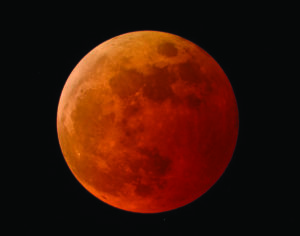Mark your calendars: there will be a total lunar eclipse on the night of Sunday, May 15, visible into the wee hours of the 16th.
Lunar eclipses are different from the more dramatic day-turns-into-night solar eclipses. A solar eclipse occurs during the day when the Moon lines up directly between the Sun and Earth. The Moon’s shadow then traces out a path of totality — a swath of surreal darkness — over a small part of Earth’s surface until the Moon passes across the solar disk.
In contrast, lunar eclipses occur at night when Earth comes directly between the Sun and Moon. In a lunar eclipse, it is our shadow that falls across the Moon’s surface. Lunar eclipses occur only during full moons; on average, there are two each year.

To see the eclipse, step outside late on the night of May 15 and find the Moon in the southern sky. Beginning at 10:30 p.m., you’ll see the eastern (left) edge of the Moon begin to dim and take on a reddish tint; that’s Earth’s shadow encroaching.
Over the next hour, the red shadow will creep westward (to the right) until it completely engulfs the Moon by 11:30 p.m. This period of totality will last about an hour and a half, during which the formerly brilliant white full Moon will have transformed into an ominous red one. Depending on local atmospheric conditions, its color can range from deep maroon to blood red to reddish orange — a “blood Moon” is what a lot of people call this phenomenon. The process then reverses, and the eclipse will end by 3 a.m.
Why does Earth’s shadow make the Moon look red? Shouldn’t it be totally dark? That’s what solar eclipse totality looks like. The answer is related to two common questions regarding the natural world: why is the sky blue, and why does it change to red at sunrise and sunset?
Sunlight contains light of many different wavelengths, ranging from long-wavelength radio and infrared to the visible spectrum to very short-wavelength ultraviolet and X-rays. Within the visible spectrum, we perceive different wavelengths as different colors. From longest to shortest wavelengths those are red, orange, yellow, green, blue, and violet. When those light waves travel together in an orderly manner, we perceive white light: all the colors together.
But something interesting happens when light travels through Earth’s atmosphere. The shorter wavelengths — blue and violet — tend to strike and reflect off the air molecules. The longer wavelengths — orange and red — are less affected. As the scattered blue and violet light strikes air molecules, their effect is amplified and dispersed. And because our eyes are more sensitive to blue than violet, and because the Sun puts out more blue than violet light, we see a blue sky.
At sunrise and sunset, when the Sun is very low in the sky, its light travels through significantly more of the atmosphere than it does when it’s higher overhead. The blue light is scattered even more, reaching the point where it’s not just dispersed but nearly banished. And clouds and dust add their own scattering. This leaves only yellow, orange, and red wavelengths to light up the sky as the Sun sets or rises.
What does this have to do with lunar eclipses? When our shadow covers the Moon’s surface, some sunlight slips past Earth’s edges and through our atmosphere. And as we’ve learned, the atmosphere scatters the shorter wavelengths, so that only longer wavelengths — the orange and red light — make it through to strike the Moon and reflect back to our eyes. You can think of it as all the red sunrises and sunsets occurring on Earth at that moment being focused onto the Moon.
The human imagination has created many stories to explain lunar eclipses. A common theme is that an animal, like a jaguar or wolf, is devouring the Moon and staining it with blood. Some cultures have imagined demons attacking the Moon. And not surprisingly, throughout history, many people have regarded lunar eclipses as ill omens.
Even in 2022, with an understanding of the orbital mechanics that drive eclipses, I find myself unsettled by the sight of a blood moon. The cold, eerie darkness of a solar eclipse is even more disturbing. Mark your calendars for April 8, 2024, when North America will next experience a total solar eclipse. (For the story of our last partial one, read “By the Otherworldly Light of a Partial Eclipse,” on the Indie website.)
I encourage you to see this eclipse. Totality at 11:30 p.m. is not so bad. I had to drag myself (and my dogs) out at 3:30 a.m. last November for the previous lunar eclipse. Let’s hope the weather will smile upon us. Clear skies to us all!
